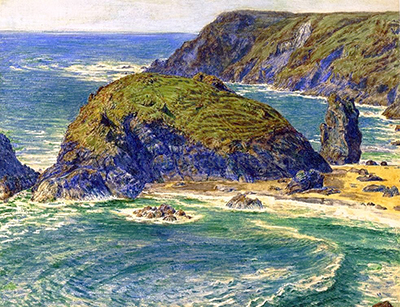 Buy Art Prints Now
Buy Art Prints Nowfrom Amazon
* As an Amazon Associate, and partner with Google Adsense and Ezoic, I earn from qualifying purchases.
Watercolour painting has held a signficant role within British art, going back many centuries. This portable medium has proven an accessible way of capturing the beautiful countryside found here. William Holman Hunt was a skilled watercolourist, and this section focuses entirely on his work in this medium.
William Holman Hunt found advantages in using both oils and watercolours and would often capture the same themes with both. For example, when travelling around Cornwall in the South West of England he would produce oil paintings and watercolour landscape scenes from the same positions, often overlooking rocky cliff tops with stunning blue seas. Watercolour painting was perhaps used more in British art than in any other part of Europe and holds a respected status within this region. The tones found here and finishes of gradiented marks of water seem to suit the unique landscape found here. Additionally, when the artist was travelling around the Middle East he would sometimes find it hard to persuade locals to pose for him and, as such, most of his watercolour paintings from this region would be brightly coloured landscape scenes.
The artist was famous for incorporating huge levels of detail into his work, and continued this technique into his watercolours. That was relatively unusual, as most artists would leave large plains of single colours using this medium, and leave a more expressive finish rather than concerning themselves with every last element of the composition. The fast-drying nature of them meant that many would have to work equally quickly and therefore avoid anything that was not entirely spontaneous. Holman Hunt could not adjust to this style and preferred planning and control of every element. He was known to be particularly single-minded and ambitious, which was part of the reason for his continued experimentation with a wide variety of mediums, from watercolours to oils, drawings, relief etchings and even the presentational frames themselves.
On the rare occasions that he did not go into minute details, it would be when using this art form to produce fast sketches in a similar way to how he produced pencil drawings. The different between the two were that his fast watercolours would also have a variety of colour that might help him in planning later pieces. One side point from his focus on huge amounts of detail right across each composition was that it would become harder to decipher which was the main focal point of each painting, though this did not concern the artist at all. Holman Hunt sometimes finished off his watercolours with the addition of other mediums in order to add a greater depth to his work. These included touches of white pen or ink, once the watercolours have dried, in order to give an extra level of detail and turn the piece into a truly presentable artwork to rival his works in oil. Many artists have used watercolours as a means to practicing future oil paintings, but without committing as much time. It is a halfway-house between study drawings which are faster, but with the ability to try out colours that might be found in the final artwork.




